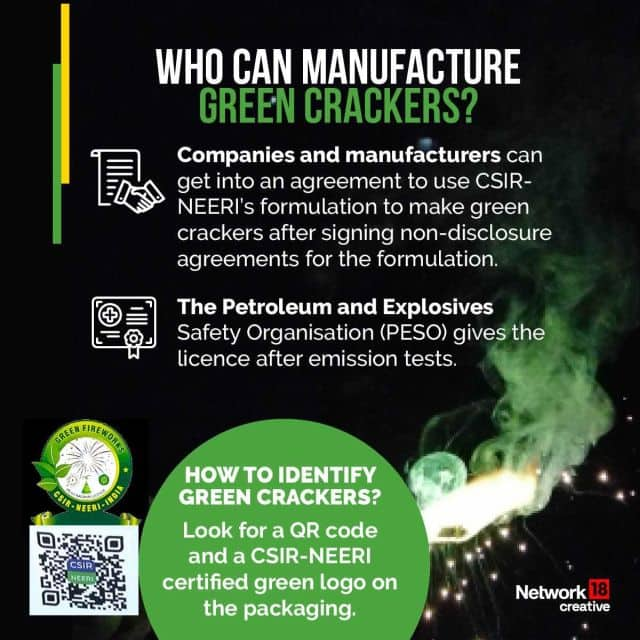No, Supreme Court has not banned all firecrackers: What's allowed, what's not?
Delhi’s air has left its people gasping for air. Mumbai is breathing heavy too. As the air quality dips in different parts of the country, leaving Indians gasping for clean air, the Supreme Court reiterated its earlier decision on firecrackers, stating that only the use of green firecrackers will apply not just to Delhi-NCR but across the country.
The order from a bench of Justices AS Bopanna and MM Sundresh came after they were hearing an application seeking to direct Rajasthan to implement the court’s order banning use of certain firecrackers and reducing air and noise pollution.
“At this juncture, no specific order will be necessary in as much as this Court, in the course of hearing the petitions, has passed several orders, where steps have been indicated to minimise and avoid air as well as noise pollution. Hence the said orders will bind every state in the country, including the state of Rajasthan. Therefore, we make it clear that the state of Rajasthan would also take note of this and take all steps to minimise air and noise pollution, not only during the festival season, but even thereafter,” the bench said.
Does this mean that the court has banned all crackers? If not, then what crackers are allowed to be used? And can they help in reducing pollution?
What did the Supreme Court say about crackers?
On Tuesday (7 November), the Supreme Court said that its previous order against the use of barium and banned chemicals in firecrackers was applicable across the country and not just the Delhi-National Capital Region.
In 2018, the apex court had banned the production and sale of all crackers except ‘green crackers’ and those with reduced emissions. It also banned the use of barium salts in fireworks and said their noise levels should be within permissible limits. At that time, the court had also set time slots for bursting crackers – between 8 pm and 10 pm on Diwali and between 11.55 pm and 12.30 am for New Year and Christmas.
Also read: Living in ‘gas chambers’: What is making Delhi’s air so toxic?
Later, in 2021, the Supreme Court had once again stated that there was no total ban on the use of firecrackers, but on those containing barium salts. It also noted that this was being blatantly violated and warned that officials would be “held personally liable” for lapses.

So, what crackers are allowed?
The apex court has allowed the use and sale of green crackers. But what are they?
Green crackers are low-emission crackers free of harmful chemicals like sulphur nitrates, arsenic, magnesium, sodium, lead, and barium. They were developed and designed by Council for Scientific and Industrial Research (CSIR)-National Environmental Engineering Research Institute (NEERI) in 2018, as citizens of the country were left gasping for clean air with pollution levels soaring to record highs.
Green crackers are reportedly manufactured from alternative raw materials, leaving a smaller carbon footprint on the environment and posing lesser risk to one’s health. However, green crackers aren’t non-polluting; they cause lesser pollution than the traditional crackers.
Green crackers cause 30 per cent less air pollution as compared to traditional ones. “Green crackers reduce emissions substantially and absorb dust and don’t contain hazardous elements like barium nitrate. Toxic metals in traditional crackers are replaced with less hazardous compounds. According to the National Green Tribunal (NGT), green crackers are permitted only in cities and towns where air quality is moderate or poor,” Dr Ravindra Khaiwal, professor at PGIMER’s department of community medicine and School of Public Health, Chandigarh, was quoted as telling Indian Express.
Moreover, green crackers are also less-noise polluting. It is said that regular crackers emit about 160 decibels of sound, whereas green crackers have a sound level of 110-125 decibels.
But what makes them less polluting that the traditional ones? Experts note that traditional firecrackers contain chemicals such as sulphur nitrates, arsenic, magnesium, sodium, lead, and barium.
These can impact the nervous system as well as the respiratory system. For instance, lead in crackers impact the nervous system. Copper triggers respiratory tract irritation. Additionally, sodium causes skin issues and magnesium leads to mental fume fever. Cadmium not just causes anaemia but also damages the kidney while nitrate is the most harmful, which causes mental impairment. The presence of nitrite causes irritation in mucous membrane, eyes and skin.

However, green crackers do not contain these chemicals. They use alternative chemicals, which makes their polluting capability lesser than the traditional ones.
What are the curbs imposed by states on crackers?
Even prior to the Supreme Court’s order on the restriction on crackers, some states had already passed laws on their sale and use.
For instance, in Delhi, Environment Minister Gopal Rai announced that all firecrackers will be banned in the Capital. Furthermore, even the storage and manufacturing of crackers will be banned in the Delhi-NCR region, with Rai adding that the police had been asked not to issue licences for firecrackers.

Meanwhile, in Maharashtra, the bursting of crackers has been limited to only three hours – 7 pm to 10 pm – until Diwali by the Bombay High Court. In their order, the judges noted that citizens have to choose between a disease-free environment and bursting firecrackers during Diwali in Mumbai. “We are not banning it. We are not experts to understand if firecrackers impact the environment, and if they do, then up to what extent. We cannot straightaway say no bursting of firecrackers. That is for the government to consider,” said the court.
Similarly, the state of Karnataka has directed officials to restrict the bursting of crackers this festival between 8 pm and 10 pm only.
States such as Punjab and West Bengal will only allow the sale of green crackers.
With inputs from agencies
from Firstpost India Latest News https://ift.tt/j5Sl7QZ
Roshneesh Kmaneck

Comments
Post a Comment